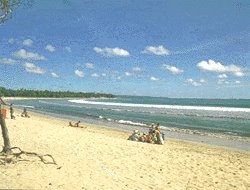 Sunsets make memories at Kuta beach, one of the island's loveliest seacoasts. Skylight descends in warm waves of color, leaving shy stars behind. Village fishermen often set off at dusk, the sails of their prahus shrinking to frail silhouettes that drift across a wide, red sun. They vanish into the night, lulled by the rhythm of waves breaking on a beach longer than vision can discern. They return when the young warmth of early morning lights up the slopes of Mt. Batukau and, on clear days, the mountains on the eastern tip of Java.
Sunsets make memories at Kuta beach, one of the island's loveliest seacoasts. Skylight descends in warm waves of color, leaving shy stars behind. Village fishermen often set off at dusk, the sails of their prahus shrinking to frail silhouettes that drift across a wide, red sun. They vanish into the night, lulled by the rhythm of waves breaking on a beach longer than vision can discern. They return when the young warmth of early morning lights up the slopes of Mt. Batukau and, on clear days, the mountains on the eastern tip of Java.
Save for the fishermen, the villagers usually busy themselves at sundown and rarely wander down to the beach to sit quietly watching the sun set into thek$ea. Mads Lange, South Bali's first European resident, most have enjoyed it though. An Englishwoman, Ketut Tantri, who lived through th_e early years of the revolution in Bali and Jaxle, built a house at Kuta beach. The Kuta Beach Hotel, built on the same site, was opened in 1959, but guests were few. Only in the late sixties did young travelers, at home riding the waves of Hawaii and California and elsewhere, begin to frequent the beach. At that time, almost everyone stayed in Denpasar, coming to Kuta for a swim, the sunset, a kris dance and sometimes a night on the beach. The villagers of Kuta were farmers and fishermen and metal smiths, and they were rather surprised at the great interest their beach received. But like many Balinese, they saw there was a profit to be made. For a small charge they invited the travelers into their homes. Home-stays were set up everywhere. These are clean, simple and cheap accommodation. A number of larger hotels, such as the Kartika Plaza Bali and the Oberoi, have also sprung up. There are many restaurants serving all kinds of westernized dishes and "soul" food, and mini-boutiques selling Bali beach fashions abound everywhere. Tourist activity has spread north up the coast to Legian and beyond on the road to Krobokan. It is said the goddess of the sea claims at least one victim each year at Kuta beach, so be careful-at times there is a strong undertow. Mostly, however, it is fine swimming and the body surfing is great. Kuta and Ulu Watu have waves as fine as anywhere in the world for board surfing. Boards aret(yr hire. The Surfing Club of Bali was set up by an Hawaiian-in-residence and a Lifesaving Club patrols one section of the beach. In 1 981, Kuta hosted international surfing and lifesaving events on its golden beaches.
As the size and fame of Kuta spread, the beach became popular with the residents of Denpasar. Indonesians from the large cities of Java came by the tour load. Dozens of art shops opened along the main streets. On the beach, girls and women carry bundles of sarongs and batiks on their heads, looking for customers. Young boys sell dance tickets, and young girls sell cold drinks. At sunset, the beach is a lively place, and the roads are full of cars and motorbikes.
At Kuta, the water stays warm late until after dusk, like its saffron reflections; and the smooth descent of the shore suits anything from building sandcasties to taking long walks. Local beachcombers are on hand gathering fans of white coral and stringing cowries into long necklaces to sell. The Balinese sometimes comefrom near and farto perform rituals bythe ocean. Although all the ritzy nightclubs are at Sanur Kuta after dark is a popular place for young visitors to eat, drink and be merry. There is a night market, one ortwo informal discotheques and numerous bars and restaurants serving good food at moderate prices. Almost every evening there is a performance of Balinese -dance somewhere in Kuta.. To know what is on just ask around.
Wednesday, January 11, 2006
KUTA BEACH
Posted by DhaniBoy at 11:36 PM
Subscribe to:
Post Comments (Atom)

No comments:
Post a Comment